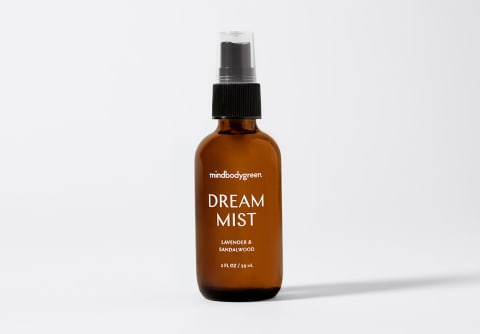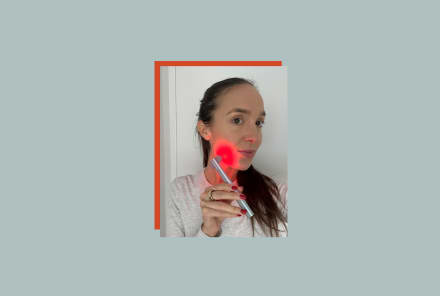Advertisement
A Basic DIY Linen Spray Recipe + How To Customize It For Your Mood

Scented linen sprays can be useful for refreshing clothes between launderings, masking odors on cloth furniture, and reviving stale air. And considering they're basically just shelf-stable water that smells good, they're super easy to DIY.
Here's how to mix a blend of your favorite scents and spray your way to a fresher home.
Why make your own?
While you can absolutely buy a premade linen spray, you'll want to be mindful of its ingredients.
Scented sprays can bring potentially harmful compounds like benzene1, formaldehyde2, toluene, m,p-xylene1, and phthalates into your home, so if you are going with store-bought, read the brand's materials carefully and look for transparent blends that explain what ingredients are being used and why. For example, many brands list essential oils' specific compounds, so you can better identify any potential irritant—this is a good thing and can help users understand if the product is right for them.
Making your own blend is a good way to ensure you're avoiding ingredients you don't feel comfortable with and not accidentally spraying your home up and down with something that could disrupt hormones or aggravate allergies.
DIY sprays are also cheap, easy to make, low-waste (you'll save on plastic packaging by using reusable glass bottles), and endlessly customizable.
A simple base recipe (with alcohol).
The alcohol in this recipe acts as an emulsifier and preservative. It helps the water and oil in your spray blend better and keeps things shelf-stable.
Ingredients:
- 16-ounce amber spray bottle (make sure it's a dark bottle to protect your oils from light and keep them from spoiling)
- 25 to 40 drops of essential oil(s), depending on how strong you want your scent to be
- 1 cup vodka or witch hazel
- 1 cup distilled water
Method:
- Combine ingredients in your bottle and shake well before using.
A simple base recipe (without alcohol).
If you prefer an alcohol-free recipe, you can ditch the vodka and witch hazel and just use essential oils and water.
Blends without preservatives will not last as long and should be used up quickly—hence the smaller size of this recipe.
Ingredients:
- 2-ounce glass spray bottle (since you're planning to use this one quickly, it doesn't matter if the bottle is dark or not)
- 2 ounces distilled water
- 30 drops of essential oil
Method:
- Add oils to your bottle and fill to the top with water. Shake well before using.
Customizing your recipe.
Now for the fun part: crafting your scent! The sky's really the limit here, and you can stick with one or two essential oils or experiment with a more elaborate, layered blend.
The one caveat is that since this spray will be coming in contact with your skin, essential oil authority and founder of Osmia Organics Sarah Villafranco recommends avoiding oils that are minty (spearmint, peppermint) or hot (cinnamon, thyme), as they may cause irritation.
Taking suggestions? Here are some functional-yet-fragrant combinations that essential oil experts adore. Feel free to adjust the number of drops depending on the size of your spray bottle when you're recreating at home. Just try to keep the ratios more or less consistent.
For a quick pick-me-up: orange (15 drops), grapefruit (10 drops), lemon (10 drops)
Jodi Cohen, founder of Vibrant Blue Oils and the author of Essential Oils To Boost the Brain and Heal the Body, shared this energizing, uplifting blend of fragrant citrus oils. It'd be a great one to spritz into the air once the 4 p.m. slump hits.
For cleaning fabric: lavender (10 drops) and lemon (15 drops)
"The best oils for cleaning and refreshing—without staining fabric—are lavender and lemon," says Cohen. "Both have antibacterial, disinfecting properties and clean and refreshing smells. Lemon can also be a powerful stain remover."
For particularly smelly clothes, you can give the spray some more oomph using cedarwood. Cohen says to add 20 drops or so for a calming, grounding fragrance that also packs a cleaning punch3.
For focus and attention: peppermint (10 drops) and rosemary (15 drops)
This is the blend to keep near your desk and spray into the air before a cognitively demanding task. Cohen points to research that's found that 1.8-cineole, one of the main compounds in rosemary essential oil, may improve speed and accuracy on cognitive tests4, and peppermint oil can enhance memory5.
For setting the mood for restorative rest: lavender (15 drops) and atlas cedar (15 drops)
Villafranco says that this is the blend she's used the most over the years, and it was on heavy rotation at bedtime when her kids were little. Lavender's relaxing qualities are well known, and cedrol, a compound in cedar essential oils, has also had calming effects6 in animal trials.
"Skip the pillowcases and spray the headboard instead, since sleeping with your face (especially the eye area) in contact with essential oils can be irritating for many skin types," Villafranco recommends.
FAQs.
Before you get started spritzing and spraying, here are some final thoughts on how to get the most of your blend:
Do essential oils stain clothes?
When spraying clothes or fabrics, you'll want to use essential oils that are light in color.
Some oils like German chamomile, spikenard, and tansy come in bright hues that could leave a mark. If you're not sure what colors your oils are, spray on a small test patch of fabric first to be on the safe side.
What can I use the spray on?
Your headboard, sheets, body towels, soft furnishings, and clothing are all fair game with a DIY linen spray—but Villafranco recommends spraying with a gentle touch and avoiding the parts of clothes that brush up against sensitive skin areas and could cause aggravation. Avoid those collars and hoods!
You can also use your spray as an air freshener.
What kind of oils should I use?
"You definitely want to choose your essential oils carefully since they’re going to be in contact with your skin," says Villafranco. She and Cohen agree that wild-harvested or certified organic oils are your best bet here.
How should I store my spray?
Sprays that have preservatives will do best when stored in a dark amber glass bottle and kept in cool, dry conditions. They should last for up to two to three months. You'll know your spray has gone bad once it loses its smell and/or starts to look murky, in which case it's time to toss it and mix up a new one.
What to look for in a store-bought option.
Pillow and linen sprays are popular products produced by both beauty and home-care brands alike. These little numbers can be used in a variety of ways, including in your shower, prior to meditation, or to set the mood for restorative rest. Many natural and clean brands make delightful formulas that use responsible ingredients that you can feel comfortable with.
When shopping for one, the first step is to look at the fragrance ingredients (typically essential oils). Of course, avoid any notes that cause you irritation—for example some love florals, while others find them too pungent. From there, you can check out the other ingredients used; these are things like emulsifiers and preservatives. There are many good options on the market, like sodium benzoate, citric acid, and potassium sorbate for preservatives and Polyglyceryl-10 Laurate and Polyglyceryl-10 Oleate for emulsifiers. (Don't let the long names scare you!) Finally, many brands also list out the essential oil compounds, per new regulations in some states; these are things like linalool and benzyl alcohol.
Check out our favorite pillow mists here.
The bottom line.
Making your own linen spray is a fun way to keep your home smelling fresh while experimenting with some new scent combos. Just be sure to use organic essential oils that are light in color to spray it safe. And while you have your essential oils out, check out these other smell-good ways to use them at home.
Watch Next
Enjoy some of our favorite clips from classes
Enjoy some of our favorite clips from classes
What Is Meditation?
Mindfulness/Spirituality | Light Watkins
Box Breathing
Mindfulness/Spirituality | Gwen Dittmar
What Breathwork Can Address
Mindfulness/Spirituality | Gwen Dittmar
The 8 Limbs of Yoga - What is Asana?
Yoga | Caley Alyssa
Two Standing Postures to Open Up Tight Hips
Yoga | Caley Alyssa
How Plants Can Optimize Athletic Performance
Nutrition | Rich Roll
What to Eat Before a Workout
Nutrition | Rich Roll
How Ayurveda Helps Us Navigate Modern Life
Nutrition | Sahara Rose
Messages About Love & Relationships
Love & Relationships | Esther Perel
Love Languages
Love & Relationships | Esther Perel


















